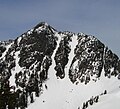| Mount Hanover | |
|---|---|
 West aspect, seen from Hat Pass | |
| Highest point | |
| Elevation | 1,748 m (5,735 ft) [1] |
| Prominence | 228 m (748 ft) [1] |
| Parent peak | Brunswick Mountain (1,788 m) [1] |
| Isolation | 1.45 km (0.90 mi) [1] |
| Listing | Mountains of British Columbia |
| Coordinates | 49°29′57″N123°11′02″W / 49.49917°N 123.18389°W [2] |
| Naming | |
| Etymology | House of Hanover |
| Geography | |
 | |
| Interactive map of Mount Hanover | |
| Location | Cypress Provincial Park [3] British Columbia, Canada |
| Region | Squamish-Lillooet Regional District |
| District | New Westminster Land District |
| Parent range | Britannia Range North Shore Mountains Coast Mountains |
| Topo map | NTS 92G6 North Vancouver [2] |
| Climbing | |
| First ascent | 1913 by Don Munday and party |
| Easiest route | Scrambling via South gully |
Mount Hanover is a mountain summit located in British Columbia, Canada. [3]




